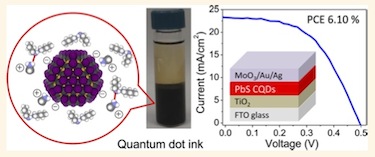Researchers at the University of Toronto in Canada and Tsinghua University in China have made a solar cell based on n-type colloidal quantum dot “ink”. The colloidal solar cell device has a power-conversion efficiency of 6%, which is a record for an ink-based colloidal quantum-dot material.
Colloidal quantum dots (CQDs) are semiconductor particles just a few nanometres in size. They can be synthesized in solution, which means that films of the particles can be deposited quickly and easily onto a wide range of flexible or rigid substrates – just like paint or ink.
In-Depth Story:
CQDs are the light-absorbing component in low-cost, potentially highly efficient inorganic solar cells. In a solar cell, photons hitting the photovoltaic material can produce excited electrons and holes (charge carriers) that have energies at least equal to or greater than the bandgaps of the material.
Another advantage of using CQDs as the photovoltaic material is that they absorb light over a wide spectrum of wavelengths thanks to the fact that the bandgap can be tuned over a large energy range by simply changing the size of the nanoparticles.
Halides passivate CQDs
A team led by Ted Sargent at Toronto, has now produced the best such CQD ink yet. Inspired by work done by Dmitri Talapin’s group (at the University of Chicago) that proved that inorganic anions can stabilize CQDs, Sargent and colleagues have directly added halides to CQDs to passivate them. These ligands not only improve solar-cell performance by removing unwanted deep electronic traps but also protect the device from oxidation.
The researchers prepared their ink using two-phase solution ligand exchange – that is, they mixed a solution of CQDs (in this case made of lead sulphide nanoparticles) dispersed on octane with iodide salts (both CH3NH3I and NaI were found to work well) dissolved in dimethylformamide. During the mixing process, the original long organics (oleic ligands) were replaced by iodide ligands. The ligand-exchanged CQDs were then re-dispersed in solvents such as butylamine, making them ready to apply to a substrate.
A one-step solution process
“Solar cells made from these films can be simply prepared by a one-step solution process,” explains team member Zhijun Ning. “There is no need to exchange ligands on the substrate or to build up the films gradually layer-by-layer as is the case in traditional methods to build high-performance CQD-based devices.” Such layer-by-layer approaches are time-consuming and wasteful since only around 1-10% of the quantum dots can be typically incorporated into the final film.
The technology paves the way for solution-processed printable CQD-based solar cells, Ning tells nanotechweb.org, and could as such significantly reduce the cost of these devices overall. “As well as allowing us to fabricate solar cells cheaply and easily, this advance might also help enhance the efficiency of CQD solar cells and indeed other CQD-based optoelectronic devices such as light-emitting diodes and photodetectors.”
The team says that it is now busy trying to make devices with even higher power-conversion efficiencies by optimizing device structure.
“Our work has also helped us better understand the mechanism by which halide ligands stabilize on CQDs,” adds Ning. “We carried out density function theory calculations to simulate the interaction between CQDs and the solvents employed and found that the linkage between organic counter ions and a solvent is crucial for maintaining charges on the CQD surfaces and preventing the dots from aggregating.”
Publication Reference:
Hertwich et al. Solar Cells Based on Inks of n-Type Colloidal Quantum Dots. University of Toronto, Key Lab of Organic Optoelectronics and Molecular Engineering of Ministry of Education, Department of Chemistry, Tsinghua University, Beijing, People’s Republic of China. ACS Nano, Article ASAP: September 16, 2014.













Comments